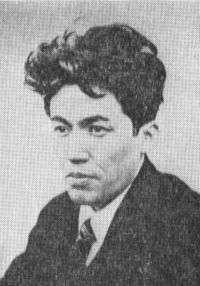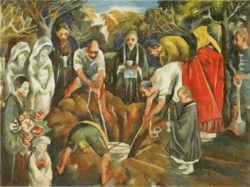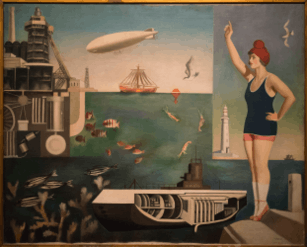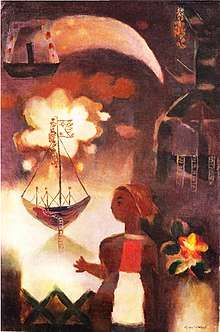Harue Koga

Harue Koga (古賀 春江 Koga Harue, June 18, 1895 - September 10, 1933) was a Japanese surrealist/avant-garde[1] painter active in the Taishō period and early Showa Period.
Biography
He was born Yoshio Koga (古賀 亀雄) in Kurume on the island of Kyushu, where his father was the head priest of the Jōdo Shinshū Temple. Described as a sickly and nervous child, he enjoyed painting and, in 1912, against his parents' wishes, dropped out of school and moved to Tokyo to study art at the Pacific Art Association and the Japanese Watercolor Painting Institute.
In 1915, he was deeply affected by the suicide of his best friend so his father, concerned about his behavior, made him return home. After a brief stay in Nagasaki, and a thwarted affair with a distant relative of his father, he entered the Buddhist priesthood and was given the name Harue (spring bough, usually a feminine name). Shortly after, he fell in love with Oka Yoshie, a local poet. His family opposed the marriage until he agreed to succeed his father as the local priest.

Shortly after, his father died and he began auditing classes in theology at what is now Taisho University while continuing to paint in his spare time. In 1917, he was hospitalized for pleurisy. On his way home to recuperate, he became ill with the flu, which turned into pneumonia. Although in critical condition, he recovered but had missed so much time at the University, he decided to quit school and concentrate on painting, after which his family withdrew financial support.
In 1922 he won awards for his paintings From the Upstairs Window and Burial, a work inspired by the stillbirth of his daughter the year before. He then came under the influence of the French cubist, André Lhote, who was very popular in Japan at the time. This was followed by an introduction to the works of Paul Klee and he painted in that style until 1929.[2] Sea, his most famous work, first appeared at the 16th Nika Exhibition in 1929. It contains various motifs which he had copied from magazines and post cards. He continued to paint in this photomontage-style, using the magazine Asahi Graph as the source for most of his motifs.[2] Other notable Koga photomontage-style works are Makeup Out-of-Doors and Intellectual Expression Traversing a Real Line. In 1929 the work Innocent Moonlit Night was also first exhibited. This colorful work displays the influence of Giorgio de Chirico, an influence that would reappear intermittently in Koga's works over the next few years.[2] The period following Sea is generally considered to be the beginning of surrealistic painting in Japan.
In 1929, he became ill and blamed it on the strain caused by participating in a major exhibition. More periods of illness followed and his condition was later diagnosed as syphilis.[3] This, together with being a heavy smoker, eventually caused a tremor that affected his work. During this period, he also became friends with Yasunari Kawabata, who lived nearby, as they apparently shared an interest in dogs.[1] As his disease progressed, he began to suffer from severe neuralgia and started behaving strangely. By early 1933, he required hospitalization and, despite various intense treatments (including malaria therapy), died later that year.[4]
Selected paintings
 Sea (1929)
Sea (1929) Intellectual Expression Traversing a Real Line (1931)
Intellectual Expression Traversing a Real Line (1931) Fireworks (1927)
Fireworks (1927)_by_Harue_Koga.jpg) Innocent Moonlit Night (1929)
Innocent Moonlit Night (1929)
References
External links
| Wikimedia Commons has media related to Harue Koga. |